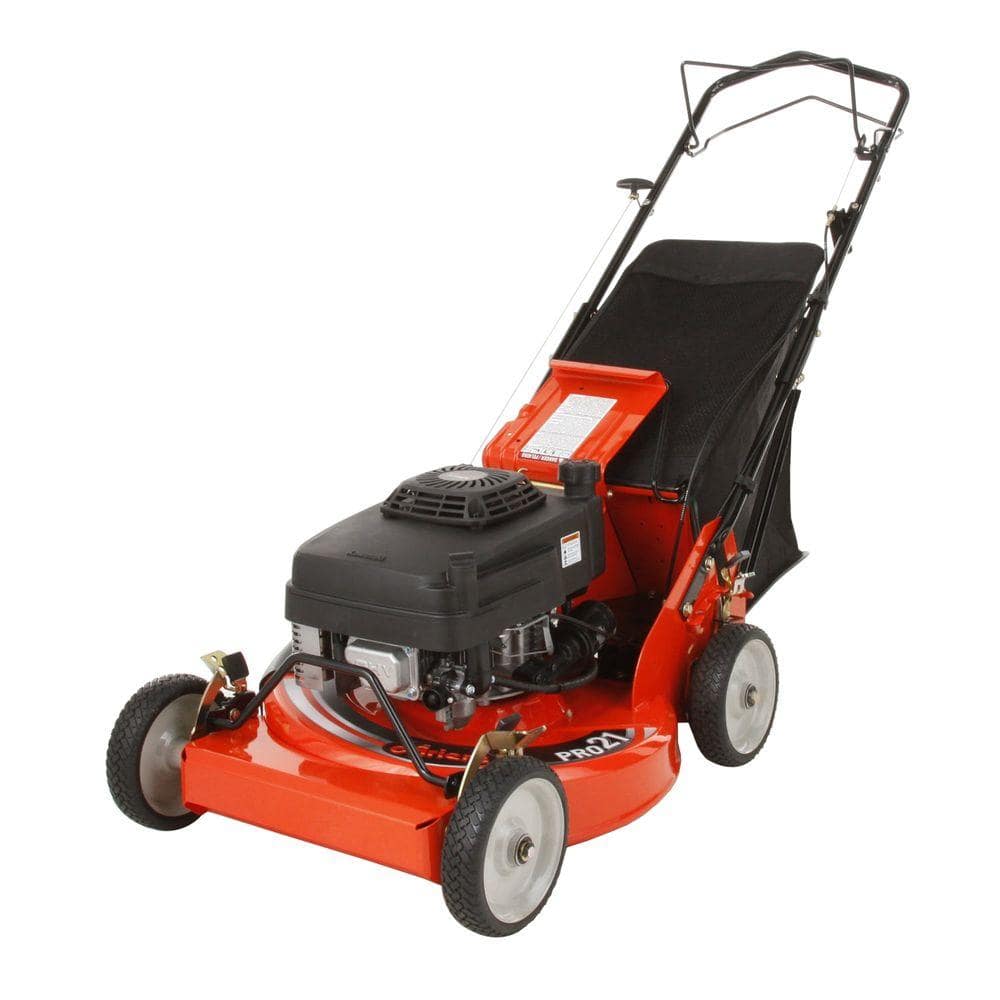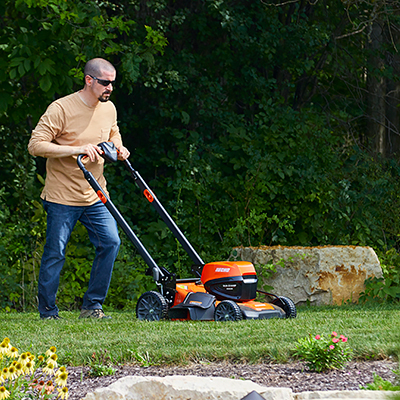Zero Turn Mowers Buying Guide

Last updated June 11, 2024
Zero turn lawn mowers provide expert movement, making them the ideal choice for cutting medium to large lawns. When you're looking for an upgraded machine to make lawn care a breeze, a zero turn lawn mower is the best choice. There are many factors to consider when choosing a zero turn mower for your yard maintenance. This guide will delve into important aspects of the best zero turn mowers, helping you make an informed decision.
Table of Contents
Why Choose a Zero Turn Lawn Mower?
Types of Zero Turn Mower Engines
The Best Zero Turn Mower Deck Size for Your Yard
Best Zero Turn Mower Features
Types of Residential Zero Turn Mowers
Mid-Grade Zero Turn Mowers
Why Choose a Zero Turn Lawn Mower?

Zero turn lawn mowers are lawn maintenance machines that can pivot 180 degrees without leaving a circle of uncut grass. They’re designed to cut closely around obstacles in your yard. This means less time spent trimming and edging your landscaping or patio. Many models feature increased horsepower and large fuel tanks.
Zero turn mowers get yard work done faster than a standard walk-behind mower. The superior option for medium to large lawns with landscaping, zero turn mowers create quick work of big jobs, saving you time and effort.
When you need to invest in a zero turn mower and mower accessories, it’s worth it to do some research. There are different advantages for each of the four main types of zero turn mowers. The main factor that will influence your choice, though, is the size of the area you need to mow.
Types of Zero Turn Mower Engines

When it comes to riding lawnmowers, engine size and horsepower are important factors. The more powerful the engine, the higher your budget will need to be. A mower with a powerful engine will cut through the grass more efficiently and last longer. Single-cylinder and V-Twin are the two types of engines commonly used in the best zero turn mowers for residential use.
- Single-cylinder models are less expensive but don’t provide powerful torque. Smaller engine mowers are better for small to medium lawns or properties.
- V-Twin-powered types of zero turn mowers deliver more power, better gas mileage, less noise and less vibration. They last longer than single-cylinder mowers. High-powered engine mowers are the best zero turn mowers for hills and large acreages. They can tackle medium and large yards with ease. These models can also move at higher speeds and tow a trailer with various tools and accessories.
The Best Zero Turn Mower Deck Size for Your Yard

The cutting deck on a mower houses the blades and cuts the grass. The wider the cutting deck, the more grass it will cut with every pass. A larger deck zero turn mower speeds up your mowing time. The size of the mower's cutting deck needs to match the size of your lawn. Larger deck mowers are ideal for large properties and commercial landscapers who cut wide-open grassy areas. Wide-cutting decks cut large areas quicker, especially when there are minimal obstacles. A smaller mowing deck is preferable for a small yard or if you need to maneuver between tight spaces. They are also easier to control and manage.
Best Zero Turn Mower Features

The best zero turn mowers are a long-term investment. Your new mower should be reliable and capable of handling your yard maintenance efficiently. Besides the engine and cutting deck, there are a few other factors to consider.
Durability is a vital feature of all types of zero turn mowers. An important factor influencing the durability of a zero turn mower is the construction of the cutting deck. Mower decks are typically made from fabricated or stamped metal. Stamped cutting decks are lighter and better suited for light yard work such as bagging and mulching. Fabricated decks offer better, sturdier designs and are ideal for landscape professionals.
Another crucial factor is the mower’s turning radius. Not all zero turn mowers have the same turning radius. The best zero turn mowers can make true 180-degree turns, spinning on a dime. Other mowers have a slightly wider turning radius, making them more difficult to navigate. If your yard has several obstacles, look for a model with a true 180-degree turning radius.
The next components to look at are the tires. Zero turn lawnmowers with wider tires will distribute their weight more evenly over a larger area. This helps reduce stress on the grass and improves traction. Look for durable, four-ply-rated tires. They’re ideal for added motion and speed.
You'll also want to consider the zero turn mower’s comfort level. You will be riding this mower for an extended period, so it needs to be comfortable. Look at the seats and support offered by different models. Measure the height of the seat’s back and determine if you want armrests. Sit in the mower to test its level of comfort. Make sure the steering wheel feels good wearing work gloves.
Types of Residential Zero Turn Mowers

Entry-level zero turn mowers are ideal for cutting a residential yard once a week or less. They are the most wallet-friendly zero turn mower. Ideal for homeowners with large properties, entry-level zero turn mowers have reliable maneuverability in small areas. They have smaller fuel tanks, meaning they cover shorter distances between refuels, which is why they aren’t typically recommended for commercial use. Typically, their speed maxes out around seven miles per hour. They may offer some special features for comfort, but they are fairly straightforward machines.
Mid-Grade Zero Turn Mowers

A slightly more robust option, the mid-grade zero turn mower is ideal for large lots that are over one acre. These spacious yards need weekly mowing that a mid-grade zero turn mower can handle expertly. They feature a larger deck size and cover more lawns faster. A mid-grade unit is designed to handle heavier loads and offer more engine options for further customization. They also tend to include more comfortable seats and deck height options than an entry-level model.
Commercial Zero Turn Mowers

Commercial zero turn mowers are ideal for landscaping professionals and commercial mowers covering large acreage daily. They feature the most powerful engines and largest fuel tanks.
Commercial models can reach up to 13 miles per hour and offer full suspension for the rider’s comfort and consistent use. Most commercial zero turn mowers feature heavy-duty steel frames and decks with large, wide rear wheels that put less pressure on the lawn surface.
Electric vs. Gas Zero Turn Mowers

Two types of zero turn mowers are currently made: electric and gas. While gas is the most common and is probably the type you’re more familiar with, electric zero turn mowers have some appealing features to consider.
- No fuel means zero emissions, lower environmental impact and no foul-smelling exhaust or other pollutants.
- The cost of maintenance is lower because they don’t need gasoline, oil changes, spark plugs, air filters, transaxles, belts or fuel stabilizers.
- The noise level is quieter, which is better for the rider and the community as a whole.
- Longevity is increased in electric mowers. They can last as many as 10 years longer than gas mowers.
- Because there’s no vibration from a gas-powered engine, the ride is more comfortable.
- The upfront cost is typically lower than electric mowers.
- Because gas mowers have been around longer, there are more maintenance providers available to service them.
- You can use the mower as long as you need to with enough fuel in the tank or a portable gas can for refills. Electric mowers take time to recharge when the battery runs out of power.
- Most gas mowers are more powerful than most electric mowers on the market.
- There are no batteries to replace every few years.
Zero Turn Mower Maintenance

Your zero turn mower is a big investment. It can be your go-to lawn care tool for years with proper maintenance. A properly maintained mower will outlast your warranty, giving you more years of use.
Here are five common zero turn mower maintenance tips to keep your mower performing season after season:
- Check air filters. Air filters can easily become clogged with dirt and debris. This can cause your mower’s fuel to burn less efficiently.
- Cleaning the mowing deck. Yard clippings and debris can build up fast under the mowing deck and can cause more damage than you may realize. Clean the deck after each use to prevent grass and lawn debris build-up.
- Sharpen blades. The blades on a mower become dull over time and with use. Dull blades tear grass instead of giving it a nice clean cut. Sharpening mower blades two or three times a year will give your lawn a fresh, clean cut.
- Check tire pressure. Low tire pressure can cause your mower deck to be uneven and produce an uneven cut. Check your tire pressure on a regular basis to ensure that one tire is not lower than the other.
- Keep it out of the elements. Properly storing your mower in a dry shelter will prevent water and other contaminants from getting inside the mower and into parts that could damage your mower.
By considering a few factors, you can choose the best zero turn mower for your yard. The wide range of available models means you can get the mower that suits your needs. During the selection process, think about your lawn conditions and what kind of engine power, deck size, durability and comfort level would work well for you.
If you want to try a zero turn mower before you buy one, The Home Depot’s mower rental might be right for you. You can use the mower and return it when you’re done, no maintenance required.

































